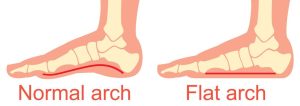Walking is a fundamental component of most people’s daily living, as being able to get from A to B efficiently enables a greater capacity for movement. Key components which provide individuals with the greatest locomotive efficiencies are the arch of the foot and the Achilles tendon. This article will focus on the former, highlighting the underlying mechanics of the arch of the foot, and informing readers of the benefits of a healthy and strong foot arch.
The arch of the foot is the genius product of human evolution derived from bipedal movement. Bony structures combined with elastic soft tissue and dense musculature create an energy efficient joint, capable of turning downwards force from gravity into forwards propulsion. The combination of bone and soft tissues creates a spring-like effect. When force is applied through the front of the foot (during running or late stages of stance phase during walking) the arch of the foot is loaded with energy, as elastic tissues stretch and bony structures compress. And when needed, the arch of the foot returns this energy to the ground in the form of forwards motion as energy is unloaded from the arch of the foot.
Unfortunately, flatfoot is a common condition in which the arch of the foot collapses, lessening the efficiency of the foot. Flatfeet can occur when the arches don’t develop properly during childhood. It can also develop later in life after an injury or from the simple wear-and-tear stresses of age. Common treatments of flatfoot are orthotics and other arch supporting objects. They keep the foot in its ideal arch shape, alleviating pain and helping with walking efficiency.
It is possible to strengthen the arch of the foot and redevelop some of the structure that has been lost. Strengthening the intrinsic foot muscles as well as tibialis posterior (muscle which reinforce arch strength) can increase the robustness and stiffness of the arch. For athletes, conditioning the arch of the foot to be able to withstand greater stressors can help prevent against injury and increase the efficiency of the structure. This leads to greater performance potential.
Two exercises which are great for foot arch strength are Toe Flexions (scrunching a towel underneath your foot) and Calf Raises with Heel Squeeze (squeezing a ball between your heels as you do a normal calf raise). For further information on foot arch health and function, consult with one of our exercise physiologists or with a podiatrist. The use of exercise and orthotics go hand-in-hand in managing foot function.




